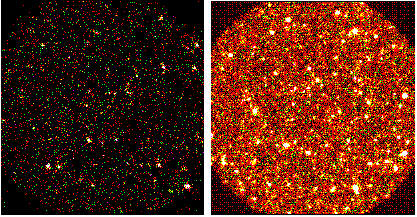 Simulations
of EPIC-pn serendipitous fields with 10ks (left) and 350ks (right), over
the 0.5-4.5 energy band
Simulations
of EPIC-pn serendipitous fields with 10ks (left) and 350ks (right), over
the 0.5-4.5 energy bandEach XMM Newton EPIC field will detect 50-250 "serendipitous" X-ray sources (see simulation).
Pointed XMM observations will thus provide an unsurpassed "serendipitous" X-ray survey (the "XMM Serendipitous Sky Survey", see Watson 1998) which, for an estimated ~ 500-1000 observations per year covering >100 deg2 , will grow at a rate of 50000-100000 sources per year, i.e. the annual rate will be comparable in size to the complete ROSAT All Sky Survey, but will go to fluxes 100-1000 times fainter.
The extended energy range of XMM Newton, compared with previous imaging X-ray missions such as ROSAT and Einstein, will mean that XMM will be capable of detecting significant numbers of obscured and hard-spectrum objects (e.g. obscured AGNs) which are significantly under-represented in earlier studies, and the improved spatial resolution will lead to better discrimination of extended sources such as galaxies and clusters.
 Simulations
of EPIC-pn serendipitous fields with 10ks (left) and 350ks (right), over
the 0.5-4.5 energy band
Simulations
of EPIC-pn serendipitous fields with 10ks (left) and 350ks (right), over
the 0.5-4.5 energy band
X-ray surveys derived from existing imaging serendipitous source samples obtained with Einstein and ROSAT have already made a major impact in a number of front-line areas of astrophysics (e.g. origin of the soft X-ray background, quasar evolution, formation of galaxy clusters, coronal activity of stars).
The impact of the much higher quality XMM data will be even wider, a fact recognised by ESA in setting up a dedicated XMM Survey Science Centre (SSC) to facilitate the exploitation of this major resource by providing a public archive of data products. This is one of the major tasks of the SSC collaboration and constitutes its follow-up and identification programme.
In short, the XID programme has been defined in terms of a core programme (CP) and an imaging programme (IP).
The CP consists of a high-latitude component, where 3 samples of 1000 sources each at X-ray flux limits in the 0.5-4.5 keV band of:
will be identified.A Galactic-plane component which will identify 1000 sources at low galactic latitudes (| b |< 20°) down to a flux limit of 1015 erg cm2 s1 will also be carried out.
The
IP consists of multi-colour optical and near infrared wide-field imaging
of a substantial number of EPIC target fields. Combining optical/infrared,
X-ray and archival information it will be possible to set up a statistical
identification method for X-ray sources, built on experience from the CP.
This strategy will allow full exploitation of the XMM serendipitous survey.
Last modified
10th March 2000
Text based on
AXIS proposal by X.Barcons and the SSC consortium.
Page designed
by J.Verdon and maintained by www_astro@mssl.ucl.ac.uk